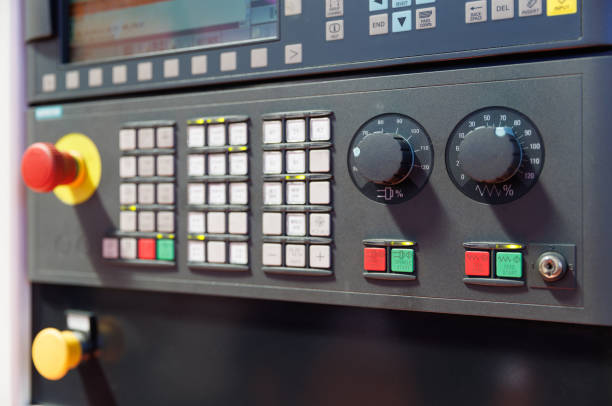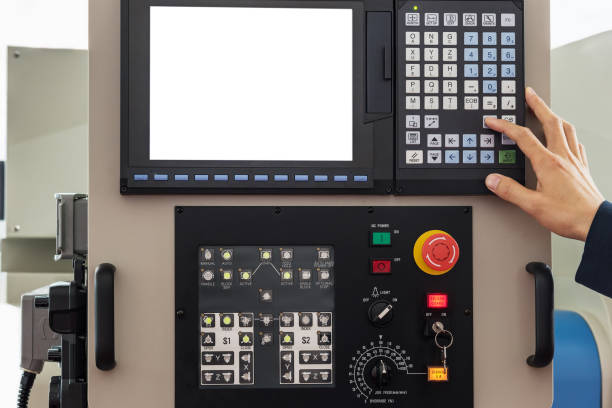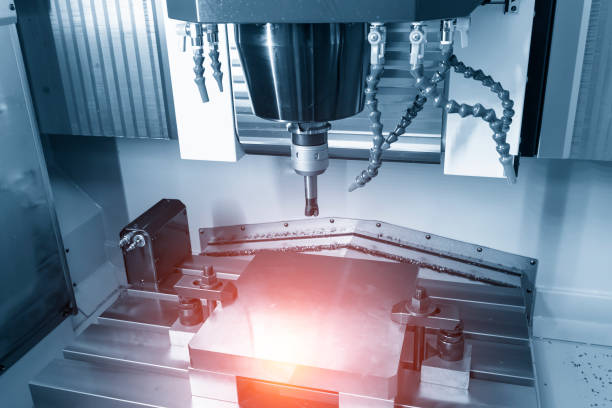The update of CNC machine control systems gives definite significant benefits. All these technologies ensure the highest level of data protection and security through their encryption processes.
They ensure the identity of a user through the use of MFA. RBAC is used for controlling access. Moving forward let me expand this on the next blog!

CNC machine control systems must be upgraded to enhance the precision of the parts being machined. Advanced servo motors enable precise and smooth movements. They regulate the spindle and axes.
This leads to improved tolerance levels. It is possible to get micrometer level accuracy. It is important for large parts. Sophisticated controls minimize manual operations. This boosts efficiency.
Newer systems also have improved feedback loops. They enhance repeatability. New software minimizes errors. This is important for quality assurance. Upgrade is critical for competitiveness in manufacturing processes.
The current CNC controls focus on speed. They cut through cycle times by a third. Faster processing enhances productivity. Improved algorithms optimize tool paths. Higher RPMs are supported by the improved drives. They glided through the materials with speed and ease.
According to the observations of users, they are able to save a lot of their precious time. New systems lower downtime. They perform rapid diagnostics. High-speed machining means short lead times.
This meets market demands. Enhanced controls deal with intricate shapes and forms. They are accurate at high speed. Achieving high speed of work is important for efficiency.
Due to upgrading, the efficiency of CNC machines is increased. Interconnected systems conserve energy. They reduce costs by twenty percent. Optimized controls enhance throughput.
Machines are at their best. Smart sensors monitor conditions. They prevent unplanned stoppages. Advanced interfaces simplify operations. This reduces training time. Efficient systems improve workflow.
They ensure consistent output. Optimizing resources leads to better profits. New machines are appropriate with lean manufacturing. Specifically, efficiency is a key driver of competitiveness.
Accurate software identifies problems in the early stage. This prevents defects. Improved hardware enhances reliability. It reduces breakdowns. Advanced diagnostics identify problems.
They enable quick fixes. Real-time monitoring ensures accuracy. It minimizes scrap rates. Advanced feedback mechanisms change variables. They maintain optimal conditions.
The reduction of errors increases product quality. Consistent performance is critical. It is always necessary to upgrade controls to improve precision. Dependable systems imply reliable standards.
Contemporary CNC control systems include diagnostic capabilities. They are useful in identifying early instances of spindle misalignments. The use of real-time data allows for the fast processing of such data. This ensures timely interventions. Vibrations are detected and measured by using sophisticated sensors.
Diagnostic tools predict failures. They assist in avoiding significant failures. Better feedback loops increase reliability. Measures of prevention are less expensive to address than measures of cure.
Early issue detection increases the lifespan of a machine. It is important to understand that these systems are vital for sustaining efficiency. Improved diagnostics help to increase the service life of the equipment.
Advanced CNC controls enhance the monitoring level. Temperature and pressure are monitored on a constant basis with the help of sensors. They detect real-time anomalies. Monitoring systems focus on spindle speed. Maintenance checks minimize cases of shocks.
They get real-time notifications for any unusual activity. Data logging helps keep track of usage patterns. This helps in predictive maintenance. Improved monitoring ability increases the life expectancy of the machines. These capabilities contribute to effective operations.
Consistent monitoring reduces downtime. New systems are necessary for the longevity of organizations.
The current CNC systems offer signals when maintenance is required. They inform users of necessary maintenance that needs to be done on their cars. They are derived from usage data. Predictive maintenance prevents downtime. Sensors monitor the condition of critical components.
They also send replacement alerts. Regular maintenance reduces breakdowns. Periodic maintenance helps improve the performance of the machines. Alerts assist with scheduling of maintenance plans.
This minimizes operational disruptions. Advanced systems help to make timely interventions. Maintenance alerts help to prolong the life of a piece of equipment.
Advanced CNC controls extend the life of the system. Components such as ball screws can be improved to be more durable. Improved methodologies in cooling avoid incidences of over-heating.
Real time control identifies problems at a very initial stage. Preventive measures are immediately instituted. Consistent performance is maintained. Maintenance alerts help to remind when to service the car. This prevents major failures. Smart diagnostics help identify the problem faster.
All these factors collectively contribute to the increase of the lifespan of the machines. For durability, upgraded controls are very important. Dependable systems enable sustainable operations.
Contemporary CNC controls enhance operational dependability. Enhanced software minimizes errors. Improved hardware reduces failures. Less disruption hampers operation of systems. Real-time monitoring guarantees ideal situations. Maintenance alerts help to avoid sudden failures.
Diagnostic services help to identify problems at the right time. Timely interventions enhance reliability. Enhanced controls are capable of performing elaborate operations.
They are precise even under full load. Reliable operations reduce downtime. This means that consistency is an important characteristic that leads to productivity and efficiency in performance.

This is because new CNC controls have been developed to reduce cycle times. Improved features enhance tool movement patterns. This minimizes unnecessary movements.
Higher RPMs, such as 10,000, improve efficiency in data processing. High-performance servo motors help to make fast transitions. Faster cycle times increase the number of parts per hour. Better controls reduce non-productive times. Such tool changes enhance the flow of production.
Enhanced accuracy prevents rework. That is, less rework means shorter cycles. Cutting down the cycle time ultimately increases productivity. Advanced CNC systems are necessary to save time.
Newer versions of CNC controls increase the level of automation. Computerized system minimizes the use of manpower. They streamline complex operations. Material loading is done by advanced robotics.
Other tools include the automated tool changers such as ATCs that enhance operations. Consistent operations reduce errors. CNC controls are also compatible with CAD/CAM software. This ensures seamless transitions. Enhanced automation boosts productivity.
A reduction in manual operations leads to spare time for the operators. Extended operations are possible with the help of upgraded systems. Enhanced automation increases efficiency. Automation depends on modern controls.
Current control technology makes everything easier. Sophisticated software links design to production line. This reduces setup times. Smart interfaces simplify programming. The parameters are easily modifiable by users. Streamlined processes improve workflow.
Real-time adjustments enhance precision. Regularity in quality also lowers the scrap level. Improved process control reduces time wastage. Integrated systems involve the linking of several operations.
This boosts overall efficiency. In the context of production processes, the term lean manufacturing is associated with smooth flows. Effective control measures are necessary for efficient operations.
New CNC controls enhance energy efficiency. Newer drives are far more efficient when it comes to power consumption. Permanent magnet motors have been shown to reduce energy consumption. Energy-saving modes optimize performance. Sensors monitor power usage.
Real-time adjustments enhance efficiency. Shorter cycle times lower energy expenses. Proper cooling mechanisms help in avoiding instances of overheating. Improved heat dissipation increases machine durability. Energy-efficient controls minimize the operating expenses.
Sustainable practices improve profitability. Advanced technologies are essential for saving energy. Modern controls facilitate green manufacturing.
New CNC controls help in controlling variation. Higher Repeatability is made possible by Precision servo motors. This maintains tight tolerances, such as ±0. 01 mm Real time control adapts the control parameter instantaneously. This helps avoid distortion at the production phase.
Consistency reduces rework needs. It helps in reducing variations across the batches. Automated processes enhance reliability. These controls reduce the likelihood of human error.
In order to produce quality goods, consistency in the production process is paramount. Advanced systems provide accurate outcomes.
Current CNC controls provide accurate input. They also employ sophisticated algorithms for precision. Spindle speeds are up to 24,000 RPM. This ensures fine finishes. High-resolution encoders improve positioning. Tight control can improve the quality of the part produced.
Automated adjustments maintain accuracy. This minimizes dimensional errors. Real-time feedback optimizes performance. Acquiring high levels of control is imperative when working on intricate shapes. Advanced controls guarantee premier quality.
New CNC controls help avoid mistakes. To ensure that problems are identified when they are still solvable, they employ sophisticated diagnostic tools. Real-time data is more appropriate because actions can be corrected instantly. This leads to a reduction in scrap rates by 15%.
Automated systems enhance accuracy. They reduce the chances of human errors. Another advantage of error minimization is better quality. Consistent monitoring prevents defects.
Better algorithms increase the degree of accuracy. Enhanced systems produce perfect goods. The reduction of errors is of paramount importance when it comes to reliability.
Advanced CNC controls help to improve quality. Newer sensors identify fluctuations immediately. Real-time monitoring maintains standards. Quality checks are automated. This cuts inspection time by 30%. Reliability guarantees high quality. Automated feedback adjusts parameters.
This keeps precision right from the production line point of view. Quality control enhances the level of satisfaction among customers. It reduces return rates. Enhanced systems guarantee the quality of products. Effective controls are critical to achieving better results.
Contemporary CNC controller cuts down on scrap. Enhanced precision minimizes errors. Real-time monitoring helps in identifying problems at early stages. This prevents defective parts. Automated adjustments maintain accuracy. Less rework means that time and costs are saved.
Reliability and dependability reduce scrapage levels. Enhanced systems produce quality products. Rework reduction boosts productivity. It ensures efficient operations.
Quality is particularly important and cannot be achieved without proper controls. Fewer errors allow the organization to avoid unnecessary rework of projects and increase efficiency.
New CNC controls integrate to guarantee product consistency across machines. Consistent parameters maintain quality. High-resolution sensors detect deviations. An automated system corrects problems right on the spot. This helps to achieve consistent parts across different batches.
Uniformity reduces quality variation. Real-time monitoring maintains precision. This helps to avoid production flaws. Consistent output ensures reliability. New control steps improve product consistency. Plain products are of standard quality. Dependable systems are critical for dependability.
In my opinion, upgrading CNC machine control systems reduces energy consumption. New software cuts down on downtime. Variable frequency drives (VFDs) control speed of a motor. This assists in curbing power consumption. It conserves energy when in use.
Less electricity consumption means less charge. Machines run cooler. Heat impacts output and durability. Less heat means lesser cooling. If machines are used effectively, then their useful life span is increased. Conserving energy leads to decreased expenditures in the course of operations.
The new generation of integrated CNC controls reduces waste. Precision machining also minimizes material waste. Accurate programming prevents errors. Less scrap saves money. Tight tolerance control leads to reduction in rework. Improved feedback mechanisms help to deliver the best results.
Sensors detect faults early. Early detection prevents defects. As with most things, less waste translates to improved efficiency. On its part, proper management of waste leads to cost savings.
CNC machine control systems increase material utilization. Precision controls allow for very specific cuts. Fewer errors save materials. More efficient tool paths decrease costs.
Newer cutting algorithms enhance the quality of cuts. Quality cuts consume less material. Sensors monitor material use. Real-time adjustments maximize efficiency. Waste minimization reduces cost. Smart technology enhances production.
Advanced CNC controls improve cost-effectiveness. Improved accuracy reduces scrap. Less rework saves money. Faster processing boosts output. Optimized cycles cut downtime. There are inevitably less errors and therefore less wastage. Sophisticated software reduces the maintenance expenses.
Sensors predict failures. Maintenance avoids large repair bills. Cost savings improve profitability. Efficient operations drive success.

CNC controls of the current generation provide data security in a more efficient way. Encryption protects sensitive information. Data encryption standards (DES) are used for safe transfers. Firewalls block unauthorized access. Firewalls built security barriers in the network.
Flaws are patched with the help of regular software updates. Updated systems prevent hacking. File security guards documents. Data backups prevent loss. Increased security measures improve costs. As known, data integrity is significant for the reliable operations.
Sophisticated CNC systems enhance the drive for users’ identification. Multi-factor authentication (MFA) is employed. MFA is a multi-step process. Biometrics introduces an additional level of security. Fingerprint scanners help to minimize cases of intruders gaining entry into secure areas.
It uses unique user IDs to monitor activities. Password policies make the use of strong credentials mandatory. This means that data is protected by secure login protocols. Enhanced authentication stops breaches. Stronger authentication saves costs.
Better CNC controls make it easier in access control. This is in accordance to the use of role-based access control (RBAC). RBAC grants permission based on the role. Only approved personnel are allowed to get into restricted zones. Access logs monitor activity.
Logs assist in determining whether there has been an intrusion or not. Programmable logic controllers (PLCs) have security limitations. Secure interfaces prevent tampering. Enhanced access control increases security. Reduced risks lower costs.
CNC systems improve the security of communication. Secure communication channels are employed. Secure Sockets Layer (SSL) helps to secure data. Virtual private networks (VPNs) safeguard remote connections. VPNs create secure connections. Network segmentation isolates systems.
Segmented networks help avoid large-scale violations. Data integrity is another aspect that is protected by using secure protocols. Reliable communication enhances operations. Enhanced security lowers risks.
Advanced CNC machine control systems can offer data protection, users’ identification and access rights. Such systems allow for encrypted messages to be sent. Enhance your operations today. Visit CNCYANGSEN to learn more!